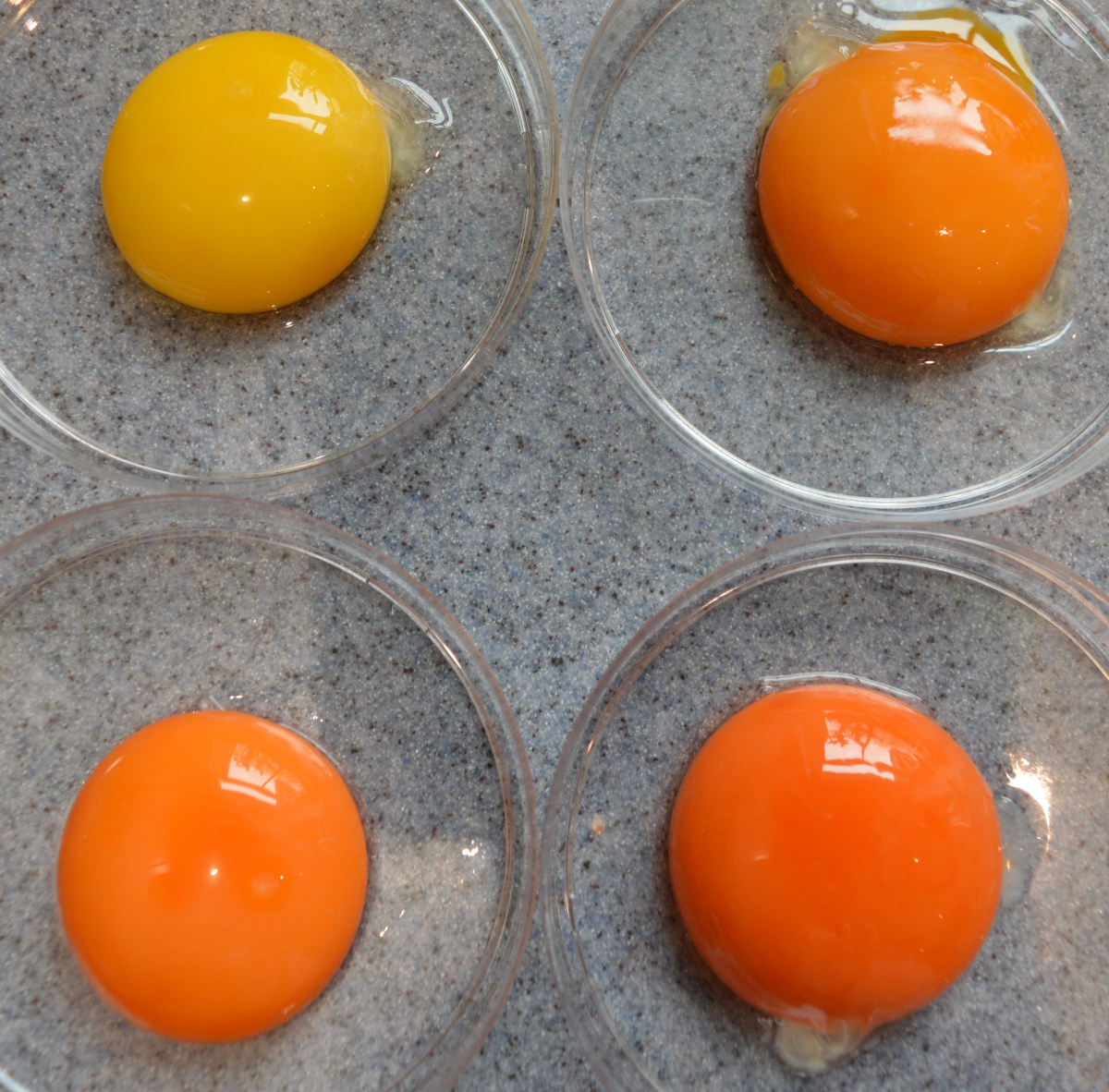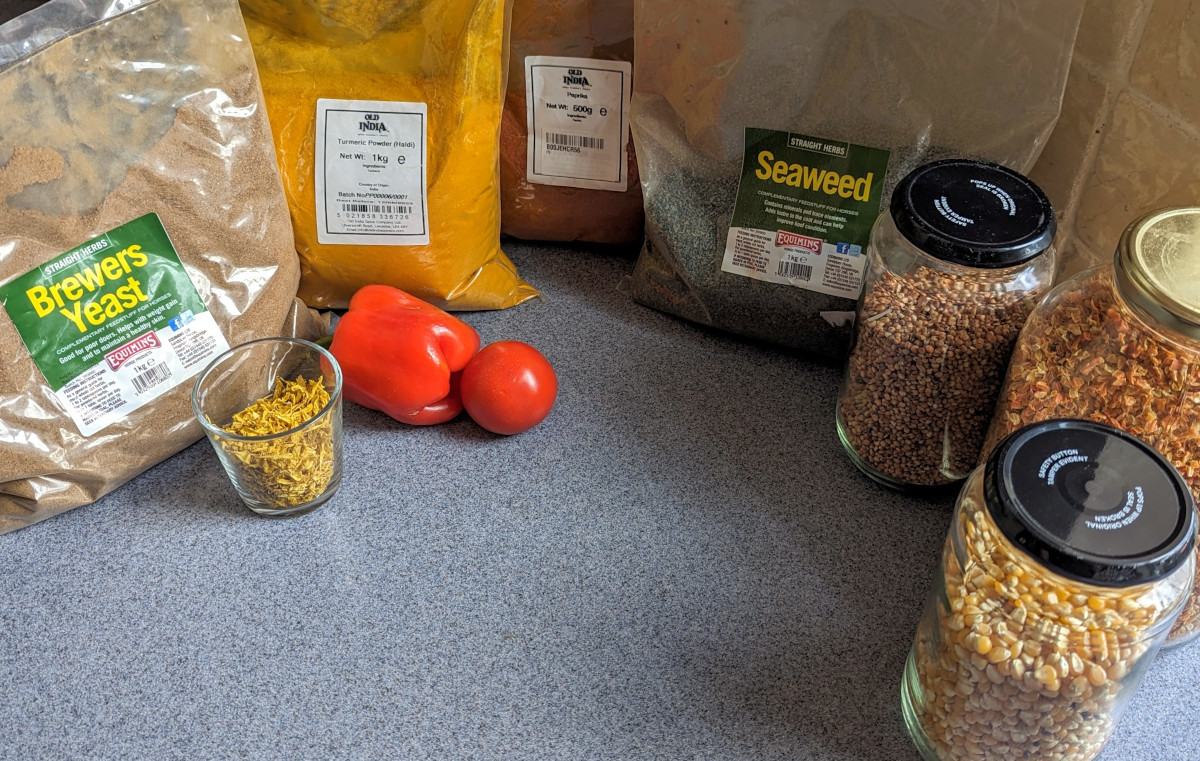From pale yellow to deep orange: A guide to egg yolk colour and why it is important.

Whatever your preference for egg yolk colour . Aside form the feed the chicken has eaten, the colour of the egg yolk is an indication of the health and well being of the chicken that laid it.
Table of Contents
Egg yolk colour is significant and it speaks volumes about the quality of your eggs. Unfortunately there is no way of knowing what colour the yolk will be without breaking the shell to have a look.
What colour should eggs yolks be?
Below: Egg yolks can be different colours and vary from pale yellow to deep orange.

This variation in egg yolk colour is due to the presence of two pigments in the yolk: xanthophylls and carotenoids. These pigments are found in the diet of the chicken.
Egg yolk colour refers to the shade of yellow or orange found in the yolk of a hen's egg.
The colour of the egg yolk is determined by the diet, genetics and living conditions of the hen. Organic egg yolks tend to be lighter and more yellow as there are fewer permitted additives in organic chicken feed resulting in a lighter yolk colour.
Hens that eat a diet rich in coloured foods, such as beta-carotene, will produce yolks that are deep orange in colour. Hens that are fed a diet low in carotenoids will produce yolks that are pale yellow in colour.
The colour of the egg yolk can indicate the quality of the egg. A bright yellow or orange yolk is an indication that the hen that laid the egg was healthy and well-fed.
To some extent the yolk colour is also an indication of the nutritional value of the egg. Eggs with a darker yolks have been shown to be richer in nutrients such as vitamins A, B, D, E, and K, as well as omega-3 fatty acids.
Eggs yolks that are Red, Gray or Black should be avoided and pure white yolks should be regarded with suspicion.
Below: Pure white yolks are normally fine to eat but not very appetising to the eye.

The chickens may be eating a poisonous plant or ingesting mycotoxins from mouldy feed.
What affects egg yolk colour?
Some eggs have brighter or differently coloured yolks than others.
The factors that can affect egg yolk colour:
- The diet of the hen: The food the chicken eats is by far the biggest factor in the colour of the yolks it produces.
- Age of the hen: Younger hens tend to lay eggs with lighter yolks, while older hens lay eggs with darker yolks.
- Breed of the hen: Some breeds of chicken are known for laying eggs with darker yolks than others.
- Season: Hens that have access to natural sunlight may lay eggs with darker yolks during the summer months when daylight hours are longer.
- Stress: Hens that are stressed or bullied lay lighter coloured yolks,
- Illness can affect egg yolk colour: Sick hens may lay eggs with lighter or even pure white yolks.
The type and amount of carotenoids or xanthophylls in the feed can affect the hue and intensity of the egg yolk colour.
For example, hens that consume more alfalfa tend to lay eggs with lighter yellow yolks, while hens that consume more corn tend to lay eggs with darker yolks. Hens fed red coloured foods like red Dari or paprika tend to lay a more orange egg.
The relationship between hen diet and egg yolk colour:
Studies have shown that by far the greatest effect on the colour of the yolk is whether the hens are allowed to free range on pasture. Free range chickens with access to grass have egg yolks that are several shades darker than their confined cousins.
Xanthophylls are yellow pigments found in plant material, such as corn and alfalfa, which are commonly used in chicken feed.
Carotenoids are red, orange, or yellow pigments found in dark green vegetables, such as kale and spinach, as well as in marigold petals.
Below: These are some of the foods and additives that affect egg yolk colour.

The amount and type of pigment that a hen consumes can affect the colour of the egg yolk.
Here is a list of foods that can affect the colour of egg yolks:
- Flower petals: Marigold or dandelion flower petals are often added to chicken feed to enhance the colour of egg yolks. Marigold petals contain xanthophylls, which are a type of carotenoid that can give yolks a rich, deep orange colour.
- Red grains: Dari, red rice and red millet add a rich orange colour to yolks.
- Dark leafy greens: Kale, spinach and most of the mustard and brassica family.
- Alfalfa: Alfalfa is a plant that is often included in chicken feed because it is rich in colouring compounds making yolks more yellow.
- Corn: Corn is a common ingredient in chicken feed, and it can also affect the colour of egg yolks. Yolks from hens that are fed a diet high in corn may be more yellow.
- Soybeans: Soybeans are another common ingredient in chicken feed, and they can also affect the colour of egg yolks. However, the effect is typically less noticeable than with other foods.
- Brewers yeast: Brewers yeast is rich in B vitamins, nearly all of which are brightly coloured.
- Paprika: A natural feed additive that add a rich orange colour to yolk.
- Turmeric: Adds a bright vibrant yellow to yolks.
- Seaweed: Full of trace elements and minerals as well as chlorophyll,
- Red or orange vegetables and fruits: Pumpkins, carrots, peppers, blueberries and tomatoes all contain significant quantities of coloured compounds which can help to colour yolk.
It's important to note that the colour of egg yolks can vary depending on a number of factors, including the breed of chicken, the hen's age, and her overall health.
Does colour affect nutritional value of the yolk?
Egg yolks are a nutrient-dense food that can be a valuable part of a healthy diet. They are a rich source of protein, healthy fats, vitamins, and minerals, such as choline, selenium, and vitamin D.
While egg yolk colour doesn't necessarily indicate nutritional value, there are some potential health benefits to consuming eggs with darker yolks.
Carotenoids, in particular, have been linked to a reduced risk of age-related macular degeneration (AMD), a common eye condition that can cause vision loss in older adults.
In one study, researchers found that people who consumed one egg per day with a high level of carotenoids had a 42% lower risk of AMD than those who consumed less than one egg per week.
Some studies show that darker and more colourful egg yolks, especially from pasture-raised hens, can have more omega-3s and vitamins due to the more natural feed the chickens eat.
Carotenoids are pigments found in some fruits and vegetables, and they can be transferred to egg yolks through the hen's diet so we get the benefit when we consume the egg.
